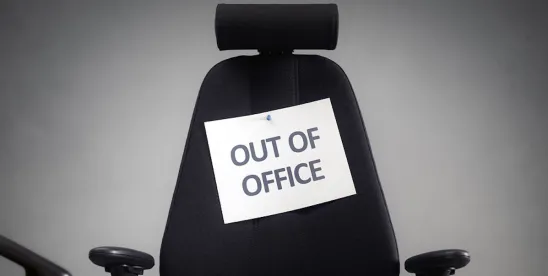Under Minnesota’s Paid Leave Law (PLL) that goes into effect in January 2026, employers must provide covered employees up to 20 weeks of leave to care for themselves and their family members with paid leave benefits available through the Minnesota Paid Leave Program.
Although the PLL was passed on May 25, 2023, employees will not be able to access paid leave benefits until January 1, 2026. In the interim, legislators and agency personnel are working to answer questions and fill information gaps.
Three important recent developments concerning the PLL include: (1) new guidance from Minnesota’s Department of Employment and Economic Development (MN DEED) for employees and employers, (2) amendments to the PLL signed into law by Governor Tim Walz on May 24, 2024, which allow for increases to payroll taxes to implement the PLL and (3) amendments which provide a comprehensive scheme for appeals and calculating benefit amounts, among other changes.
New Guidance
On May 15, 2024, MN DEED published Frequently Asked Questions Guides interpreting the PLL for employees and their families (Employee Guide) and employers (Employer Guide). Both Guides provide crucial insight into the MN DEED’s interpretation and intended implementation of the PLL. For example, the Employee Guide explains that after January 1, 2026, employees will have access to two types of state-funded leave — family leave and medical leave — for up to 12 weeks per benefit year for each type with a maximum of 20 weeks of paid leave per benefit year. The Employee Guide also explains that while leave benefits are available starting January 1, 2026, in the event an employee welcomes a child through birth, adoption, or foster care in 2025, the employee will still be eligible for paid family leave starting January 1, 2026, provided the leave is used within the first 12 months of welcoming the new child.
The Employer Guide provides much-needed guidance for employers. It directs that covered employers who do not already have an online account with MN DEED’s Unemployment Insurance Division must register for an online account by October 31, 2024, the first wage report submission date. Importantly, employers who are exempt from participating in Minnesota’s Unemployment Insurance Program (such as non-profit and religious organizations) are not automatically exempt from the PLL and may need to establish a “Paid Leave Only” employer account by the first wage report submission date. Starting October 31, 2024, employers must begin submitting “wage detail reports” (statements of employees’ wages) for the preceding fiscal quarter to MN DEED online. Employers already filing wage reports for unemployment insurance purposes need not submit a second wage detail report for PLL purposes; the wage detail report required for Minnesota Unemployment Insurance will satisfy both the employer’s unemployment insurance and PLL obligations. Finally, starting November 1, 2025, employers must post notice of employees’ rights under the PLL in the workplace. MN DEED has yet to publish an exemplar notice.
Like other state-run paid family leave programs, Minnesota Paid Leave is designed to be funded by both employees and employers via increased payroll taxes and employer premium payments. However, employers with 30 or fewer employees will be eligible for reduced payments (discussed below), and employers who offer paid family leave through a private carrier will be able to apply for exemption from PLL premium payment requirements as long as the private plan provides the same or more generous benefits. We anticipate more information on private plan exemptions will become available prior to the April 30, 2026, initial premium payment deadline. Employers who do not have a qualifying private plan can expect to make their first paid leave premium payment on or before April 30, 2026.
Legislation Allows for Increased Premium Rates
Like Minnesota’s unemployment insurance program, the PLL permits MN DEED to collect premiums in the form of a percentage of an employee’s taxable wages. The PLL initially provided for a 0.7% payroll tax on employers, half of which may be passed on to the employee. On May 13, 2024, actuarial and consulting firm Milliman presented to the Minnesota House of Representatives a report which showed a greater contribution rate was necessary to ensure the MN DEED has sufficient revenue to administer the paid leave program. Milliman predicts taxing wages at 0.88% would sufficiently fund the paid leave program. Based on Milliman’s report, the legislature adopted amendments to the PLL, effective as of May 24, 2024, that authorize the commissioner to adjust annual premium rates.
Small employers may be eligible for reduced contributions. The amendments added that employers who have up to 30 employees and pay an average wage to employees that is equal to or less than 150% of Minnesota’s average wage will be eligible for a reduced “small employer premium rate.” Small employers may also apply for assistance grants from MN DEED in a process that has yet to be determined by MN DEED.
Given this new information, employers should expect an increased payroll tax provision in the PLL, and employees can expect to contribute up to 0.44% of their wages toward the paid leave program.
New Appeals Framework; Other Changes
The most comprehensive addition to the PLL concerns the ability of benefit applicants and employers to appeal benefit determinations. The recently adopted amendments provide that employers and employees typically have 30 calendar days from the date a decision is made by MN DEED or a private plan administrator to request administrative review of a decision regarding an award of benefits under the PLL. Then, MN DEED will issue a hearing notice to the parties. Next, the hearing officer will hold a private and recorded hearing and issue a written decision providing their reason for the decision and findings of fact. Any evidence or testimony used at the hearing cannot be considered in any civil administrative, or contractual proceeding, though it can be used in a criminal proceeding. The parties can then file a request for reconsideration, which will typically be considered by the same hearing officer. No party can recover attorneys’ fees or costs against MN DEED based on the initial hearing or reconsideration. After a decision is made on reconsideration, an employer (after paying the filing fee) or covered individual (without paying the filing fee) can appeal the decision to the Minnesota Court of Appeals.
Definitions. The amendments also include changes to the definitions section of the PLL. First, an employer using a private plan to administer paid leave can choose its own definition of a “benefit year” under the statute. Second, independent contractors and self-employed individuals can opt into coverage for paid leave benefits. Third, the definition of a “family member” is expanded to include the child of a domestic partner.
Intermittent Leave. The amendments also provide needed detail regarding a covered individual’s ability to apply for benefits for intermittent leave. A covered individual’s initial paid week occurs when the employee takes a combination of seven leave days, whether those days are consecutive or nonconsecutive. A covered individual also must take intermittent leave in increments consistent with the employer’s policy, which must indicate a minimum increment of one calendar day of leave.
Calculation of Benefits. The amendments also change how benefits are calculated. Previously, the PLL considered whether an individual received an hourly wage or salary as part of the calculation for their benefit payment amount. Pursuant to the amendments, regardless of the structure of a covered individual’s income, benefit payments will be calculated based on the average hours the covered employee worked during the last two quarters before filing an application for benefits. Then, the benefit amount is calculated based on a percentage of the benefit applicant’s average weekly wage. The PLL gives employers discretion to provide employees supplemental benefits on top of the benefits received under the law, like paid time off. The amendments give employees the responsibility to return any supplemental payments received in excess of their usual income to their employer.
Retroactive Benefits. The amendments further explain when benefits become effective for covered individuals. When a benefit application is filed, the benefits take effect the Sunday of that calendar week. Previously, if an applicant wanted benefits to begin before they filed an application, the applicant could only request benefits to start, at most, seven days prior to the Sunday of that calendar week. Now, a new safe harbor provision allows an applicant who is incapacitated or failed to timely apply for benefits through no fault of their own to request retroactive payment of benefits for a period of time longer than seven days prior to the Sunday of the week that they filed. Covered individuals, however, cannot receive benefits under the PLL for certain absences or reasons for delay. The amendments added an express prohibition on an individual’s ability to apply for benefits for any time they were unable to work due to incarceration or during time they received unemployment insurance.
Reinstatement. Under the PLL, an employee generally has the right to be put back to the same position they held before starting leave upon return from paid leave. The amendments clarify that employees must be put back in a position with the same overtime pay rate and overtime hour opportunities that they received before leave, unless overtime opportunities changed for similarly classified employees.
Employer Plan Changes. The amendments also walk through what happens when a covered individual’s benefit plan changes. First, if an employer switches from the state-administered paid leave program to a private plan (or vice versa), then the plan under which the covered individual was approved for leave controls and continues to control for the total time the request was approved. Any extension or change requests made by the covered individual would then be administered by the employer’s new plan. If an employee’s employment ends, then they must still receive coverage for 26 weeks or until they secure another job, whichever occurs first.
Data Privacy. Finally, the amendments added a data privacy provision, directing that information collected pursuant to the PLL must be kept private. With some exceptions, any recorded testimony or exhibits provided regarding a benefit determination cannot be disclosed without a court order. The privacy provision also contains carveouts permitting information disclosure to certain state and federal agencies, employers, and healthcare providers.





 />i
/>i

